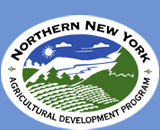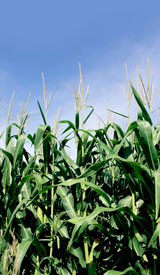


PRESS RELEASE: April 25, 2007
Contact:
Dr. Quirine M. Ketterings, Cornell University, 607-255-3061
Dr. Larry Chase, Cornell University, 607-255-2196
Farm Balancing Act: Northern NY Project Blends Crop Production, Profitability and Environmental Protection
With increasing crop production costs and greater environmental regulation of dairy farms, the question for farmers in Northern New York is are fields too full or not full enough of nutrients essential for high crop yields and good stewardship practices. Research funded by the Northern New York Agricultural Development Program is studying how to achieve optimal nutrient balance for both crop production, farm profitability and environmental protection.
In 2007, 26 Northern New York dairy farmers are working with Cornell University’s Dr. Quirine M. Ketterings, an associate professor crop and soil sciences, and animal science professor Dr. Larry Chase, and Cornell Cooperation Extension educators in Clinton, Essex, Franklin, Jefferson, Lewis and St. Lawrence counties to determine whole farm mass nutrient balances for nitrogen (N), phosphorus (P) and potassium (K).
The research team is working with an Excel Mass Nutrient Balance software program to track and collate such data as the N, P, and K composition of feeds and fertilizer brought onto the farm, milk exported off the farm, and farm-produced feeds.
Some Farms Import More Nutrients But Produce Same Amount of Milk; Researchers Analyzing Differences
Ketterings says, “An important measure of profitability and environmental impact is a farm’s efficiency in the use of nutrients to produce milk. Some farms in Northern New York imported more than three times the amount of nutrients as other farms producing the same amount of milk per cow. We initiated the project to begin to understand the differences in milk production efficiency among the farms in the expectation that it will help us find ways to improve farm economics and reduce environmental losses at the same time.”
Ketterings says that forecasted price increases in fertilizers and purchased feeds give producers an additional incentive to minimize nutrient imports and to recycle on-farm nutrients as efficiently as possible.
Nutrients arrive on the farms in the form of feed, fertilizer, bedding and animals. In 2006, 22 Northern New York farmers reported the 2005 data. For their farms ranging in size from 38 to 475 milking cows and from 100 to 1,200 crop and tillable pasture acres. Manure is spread on 83 to 800 acres per farm.
The percentage of purchased feed brought onto the farms ranged from four percent to 54 percent. The percentage of nitrogen that did not leave the farm in milk, animals, crops or manure ranged from 18 to 84 percent per farm.
Purchased feed and fertilizer account for 78 percent of the nitrogen brought onto the farms. The percentage of nitrogen that did not leave any single farm in the form of milk, crops, animals or manure ranged from four to 54 percent. Milk accounted for about 78 percent of all nitrogen exported off the farms for all but one farm that exported nitrogen via crop sales. Ten of the 22 farms in the survey sold crops off-farm in 2005.
The total annual lbs of N per acre remaining per tillable acre on any one farm ranged from 10 lbs to 196 lbs N per acre. None of the farms had negative balances.
The farms reporting 2005 cropping year data imported 0.14 to 16.03 tons more phosphorus than they exported in products each year. Feed and fertilizer accounted for most of the P imports. The percent P remaining varied from 14 to 82 percent. Milk was the major P export item on all of the farms except one. The P remaining per acre of tillable crop and pasture ranged from 1 to 28 lbs P per acre.
One of the farms that sold crops exported more potassium (K) than it imported. The other farms imported 0.06 to 35.92 tons more K than they exported. For six farms fertilizer was the major K import category. Nine farms exported most of their K as milk.
The amount of nutrients imported per hundredweight of milk ranged from 2.5 to 3.5 lbs. N/cwt milk, 0.10 to 0.55 lbs. P/cwt milk, and 0.2 to 1.0 lbs K/cwt milk.
Details May Provide Insight into Farm Efficiencies
Ketterings says, “The analysis of efficiency of farm nutrient use for milk production suggests that there are wide variations between farms with similar production levels. A detailed comparison between groups of farms with divergent nutrient use efficiencies (low versus high) may provide insight into the characteristics that make some farms more efficient than others. If we can couple that with profitability data, we might be able to develop best management practices that support greater nutrient use efficiency for greater profitability and protection of the environment.”
In 2007, the project database will be expanded to add six new farms to 20 continuing farms reporting 2006 cropping year data. A total of 59 farm years is expected to include nine farms participating in all three years of the project and 20 farms participating for two years.
The three-year dataset will be analyzed to determine what management decisions drive imbalances and what realistic options there are for increasing nutrient use efficiency on Northern New York farms.
Researchers are already working with participating farmers to evaluate potential options for lowering nutrient balances where needed.
Farmers from Clinton, Essex, Franklin, Jefferson, Lewis and St. Lawrence counties lead the Northern New York Agricultural Development Program which funds regional on-farm research, education and outreach for the farming industry. To learn more, go online to www.nnyagdev.org or contact Jon Greenwood, 315-386-3231, Joe Giroux, 518-563-7523, or R. David Smith, Cornell University, 607-255-7286. # # #
